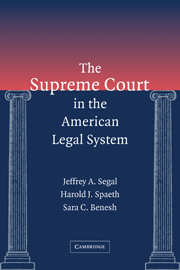5 - Evidence
Published online by Cambridge University Press: 05 June 2012
Summary
Trial court decisions, as well as those of administrative agency tribunals, depend on the facts of the matter at issue. The admissibility and inadmissibility of facts depend, in turn, on the rules of evidence. Perhaps more than in any other field of law, evidence embodies features that distort “truth” and debase “justice,” however defined. Each state has its own rules of evidence, as do the federal courts. State rules substantially copy the federal rules, although except for rules that impact constitutional provisions – such as, the privilege against self-incrimination – the states are free to devise their own.
The federal rules, however, are not exclusive to the federal courts. They do not govern the actions of the Supreme Court, and Congress has authorized various agencies, such as the Departments of Agriculture and Interior, to formulate their own rules for certain of their administrative proceedings. Congress has also specified distinctive rules for the exclusion of some imported goods, requests by convicted criminals for habeas corpus relief, and certain admiralty matters.
The original source of the rules of evidence is the common law. Codification did not occur until the middle of the twentieth century. In 1953, a national conference of judges, law professors, and lawyers approved the Uniform Rules of Evidence, which were meant for state adoption. In 1972, the Federal Rules of Evidence (FRE), drafted by another distinguished group of law-related professionals, were approved by the Supreme Court. Congress revised them somewhat, and they became effective in 1975.
- Type
- Chapter
- Information
- The Supreme Court in the American Legal System , pp. 97 - 118Publisher: Cambridge University PressPrint publication year: 2005



